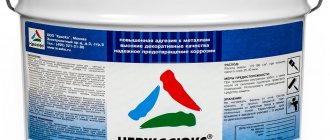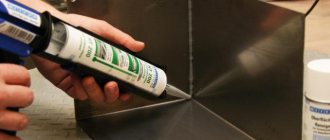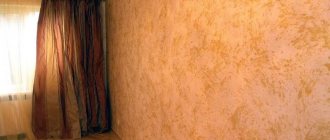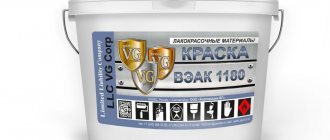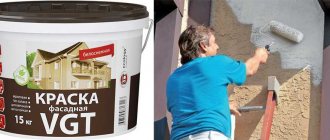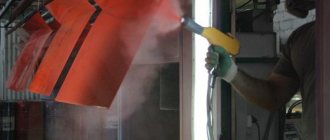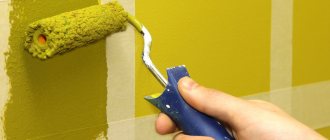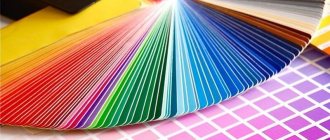Paints
Large boats are painted with two types of paints: above the waterline - one, below the waterline - another. But as a rule, an aluminum boat is painted with one paint, since the size of the boat is small, it is not a boat.
Oil paints
These are paints and varnishes based on drying oils.
All oil paints and enamels contain pigments that give them color.
An aluminum boat can only be painted with paints that do not contain lead as a pigment. Lead-based oil paints will destroy aluminum. Any other pigment in the paint will not harm the boat.
It is better to choose enamel rather than paint for painting a boat; it is more durable and glossy.
Oil paints are applied only after priming.
Epoxy paints
In recent years, an increasing number of people who decide to paint an aluminum boat or boat prefer paints based on epoxy resin.
Epoxy paints should not be applied to boats that have previously been painted with oil paints.
Epoxy paint is applied in a single layer. Coloring is done in small areas. Epoxy paint is toxic and requires caution when working with it.
Interspeed 340 or Temacoat RM finish paints fall into this category. 40.
Alkyd paints
Created on the basis of alkyd resin, the solvent is white spirit. They are less durable than acrylic ones, the boat will have to be renewed more often, perhaps annually, but the color turns out to be richer and more beautiful, and the color palette is richer.
For example, for an aluminum boat, alkyd enamel XB-124 is suitable, applied to primers FL-03K, VL-02, VL-023.
Acrylic paints
These are water-dispersed paints and varnishes on a polyacrylic base.
They are considered the most durable and inexpensive, they last a long time and do not turn yellow. For aluminum boats, for example, Mobihel car enamel is suitable.
Antifouling paint
Special paints are applied to the bottom, which is located in an environment where living plant cells grow on it and animal microorganisms adhere.
The special paint for boats is called “anti-fouling”, i.e. it contains elements that prevent various forms of life from settling on the hull. For example, International Trilux paint has proven itself well.
What paint to paint a fiberglass boat
Approximately once every 10–20 years, plastic boats require a new paint layer. You can update a fiberglass boat yourself or by professionals.
Several types of paints are suitable to protect the plastic hull of a boat:
- acrylic for cars;
- industrially prepared and homemade epoxy compounds;
- polyurethane mixtures;
- alkyd yacht enamels.
Epoxy paints are the weakest of all of these, they create a thin layer of coating, do not hold gloss well and are sensitive to weather changes. But they are cheap. Acrylic and alkyd coatings last an average of 5 years; they are much stronger and more durable than oil paints, but less resistant to damage than modern polyurethane paints. The highest quality results can be achieved with the help of advanced polyurethane compounds, but the price tag for paints in this group still keeps them in the category of luxury goods.
Paints with a fluorescent component are more accessible. They are able to accumulate sunlight and then glow in the dark. A useful feature for a boat used at night.
How can you tell if a plastic boat needs painting?
Water, objects with which collisions could not be avoided, temperature changes, improper storage - these factors destroy the decorative and protective coating of the boat. As soon as the surface of the craft loses its luster and brightness, and cracks, chips, scratches and other “scars” appear on the hull, it’s time to bring in your faithful “companion” for repairs.
How to remove old coating?
The paint is applied to the gelcoat base of the boat, created during the production of the hull in the factory. It is necessary to thoroughly clean the boat hull from the previous paint layer and create a rough surface for the new paint to adhere to the base. At the same time, experts advise not to moisten the surfaces to be sanded, but to treat them dry: blow off the dust with a strong stream of air, then wipe with a degreasing compound applied to a soft cloth. Water makes it difficult to see the boundary between the gelcoat and the old paint layer, and under water, the so-called pores - air bubbles that have opened in a smooth surface after sanding - are lost from sight.
You can remove old paint with a special remover, but you will have to pay special attention to the composition of the solvent mixture. If the remover formula specifies the substance methylene chloride, you cannot use such a solvent for fiberglass - it will corrode the polyester resins that make up the gelcoat and cause irreparable harm to the plastic boat.
The main danger when removing old paint is the possibility of damaging the gelcoat. This cannot be allowed. That's why many people try to change the color of the boat's coating during repairs - it's easier to see the boundary between the layers of finish.
How to paint a boat?
- PAINT GUN. Suitable for all types of paints. Convenient where a large number of boats are regularly processed, that is, in workshops.
- ROLLER. Suitable for painting boats at home. Not suitable for polyurethane paints: these are two-component compositions that require application only with a spray gun.
- BRUSH. Preliminary layers of primer and paint can be applied with a brush. If you are 100% accurate and have a masterly level of painting skill, the brush will give a good result on the final layer of paint.
Basic painting technology.
It is important to remember that the gelcoat coating is applied in layers:
- preparatory (sticky) primer;
- basic soil;
- dye;
- varnish
Any pores found must be filled. A special sticky primer will help further strengthen the working base of the case and enhance the adhesion of subsequent coating layers. You can paint plastic boats with just primer, but then it will take only 3–5 years before the next repair.
Fiberglass is coated with Hi-Solid varnishes or ceramic compounds. They provide shine and the most durable final coating. This varnish will not crack due to temperature changes and will withstand boat collisions with snags, fidgeting in shallows and other shocks.
Priming
When choosing paint for an aluminum boat, you need to consider what kind of primer it has been pre-treated with.
The following can be used as a primer for various paints for an aluminum boat:
- Soil VL-08.
- Soil VL-02.
- Soil GF-031.
- Zinc white.
- Zinc yellow or crown green.
- White epoxy paint EP-51.
Of course, this series can be continued.
How to cover a plywood boat
If the boat is made of non-waterproof plywood, then it is necessary to protect it from delamination of the material. The plywood boat needs to be impregnated with drying oil. To paint such a product, you need to properly prepare the boat and decide on the right paint.
After priming, painting is done with epoxy paint. It is considered the most durable of all plywood boat paints. Such paints give the surface a high level of strength, making it hard and wear-resistant.
Epoxy enamel is not suitable in this case. After painting, the boat must remain on the shore for some time, then it acquires the required hardness. Another Tikkuril coloring agent can be used to paint a plywood boat. After using it, the boat becomes hard within a week. The best type of paint for such boats is “Perfection”, the result exceeds all expectations.
If you entrust the work to professionals, the cost will be higher than painting the product yourself. Before painting, you need to inspect the problem areas of the boat and eliminate the damage. Then the boat needs to be washed from dirt and dust. It is advisable to apply paint to a perfectly clean surface.
Help from the experts (1 video)
Painted boats (18 photos)
Composition of paints and varnishes
Various primers and paints are one-component or two-component
One-component - dry after complete evaporation of the solvent. For example, one-component enamel “Krasko Nerzhalux” is applied to a phosphating primer.
Two-component - dry by reaction between two or more components. They have great resistance, but also increased toxicity. It is recommended to spray them only in a respirator.
An example of a two-component paint is EP 140 enamel. This epoxy enamel is well suited for painting an aluminum boat; it is applied over an epoxy (EP), acrylic (AK) or VL primer.
Paint schemes
Since primers, paints, and varnishes are often purchased separately, and not in any separate series, it is very important to know the degree to which certain paints and varnishes can be combined with each other.
If your painting scheme is as follows: you applied acid prime and acrylic primer to the cleaned hull of the boat, then the paint should be acrylic.
Another scheme: two layers of epoxy primer are applied to the cleaned bottom, and epoxy paint is selected.
When priming and painting a boat, you need to wear a respirator, preferably a carbon one. It will not get rid of the smell, but it will retain particles of fine dust and aerosols (if you paint with a sprayer).
Choice
There are many paints on sale, both expensive, imported, and more budget-friendly domestic ones.
It’s possible that cheap paint will work well, but people are usually afraid to try, because before that a lot of work has been done on cleaning and priming, a lot of effort and money have been spent, so many try to paint only with materials that have been tested by experience or those that were recommended.
Paint and paint systems Duxone, HEMPEL, Tikkurila have proven themselves well.
The advice is the following: before making a decision to buy paint, it is better to look at the forums to see who painted it or not and read reviews about the quality.
When choosing a paint color for your boat, keep in mind that paints fade over time and, strange as it may seem, white fades the most. But rich colored paints are more durable.
High-quality paints fade more slowly.
Method for determining paint compatibility
If you decide to partially paint the boat, then you definitely need to find out what paint it was originally painted with. Old and new paint must be compatible.
You can check paint compatibility experimentally. You can do this as follows:
- Generously wet a small piece of rag with 646 solvent.
- Place a larger piece of plastic wrap on top.
- Seal the edges of the film with tape.
- After a day, see if the paint under the film has not swelled, then you can apply any primers and paints to the surface, even epoxy and polyurethane paints and varnishes.
It is not recommended to use red lead, lead or titanium paints for painting an aluminum boat; they all destroy aluminum. Especially the rivets get it.
Features of painting boats
Aluminum boats have a number of advantages compared to such products made from other materials. They are characterized by such qualities as light weight, strength, ease of transportation and launching. To give such a boat an attractive appearance, epoxy or polyurethane paint is quite suitable. Epoxy paints serve as a primer coat, but can also be used as a top coat for the underwater part of a boat.
For aluminum boats, painting materials are tinted in different colors and shades. It should be fair to say that painting an aluminum boat is not at all easy. Paints do not adhere well to such material. Therefore, in the wrong hands, painting an aluminum boat can be a disaster.
To paint an aluminum boat, you need to follow a certain technology. Only then will the paint last for a long period of time. Possessing high chemical activity, aluminum products in the open air are covered with a protective oxide film. Therefore, the coating of the boat must perform protective and decorative functions.
In the video: painting a boat with polyurethane.
